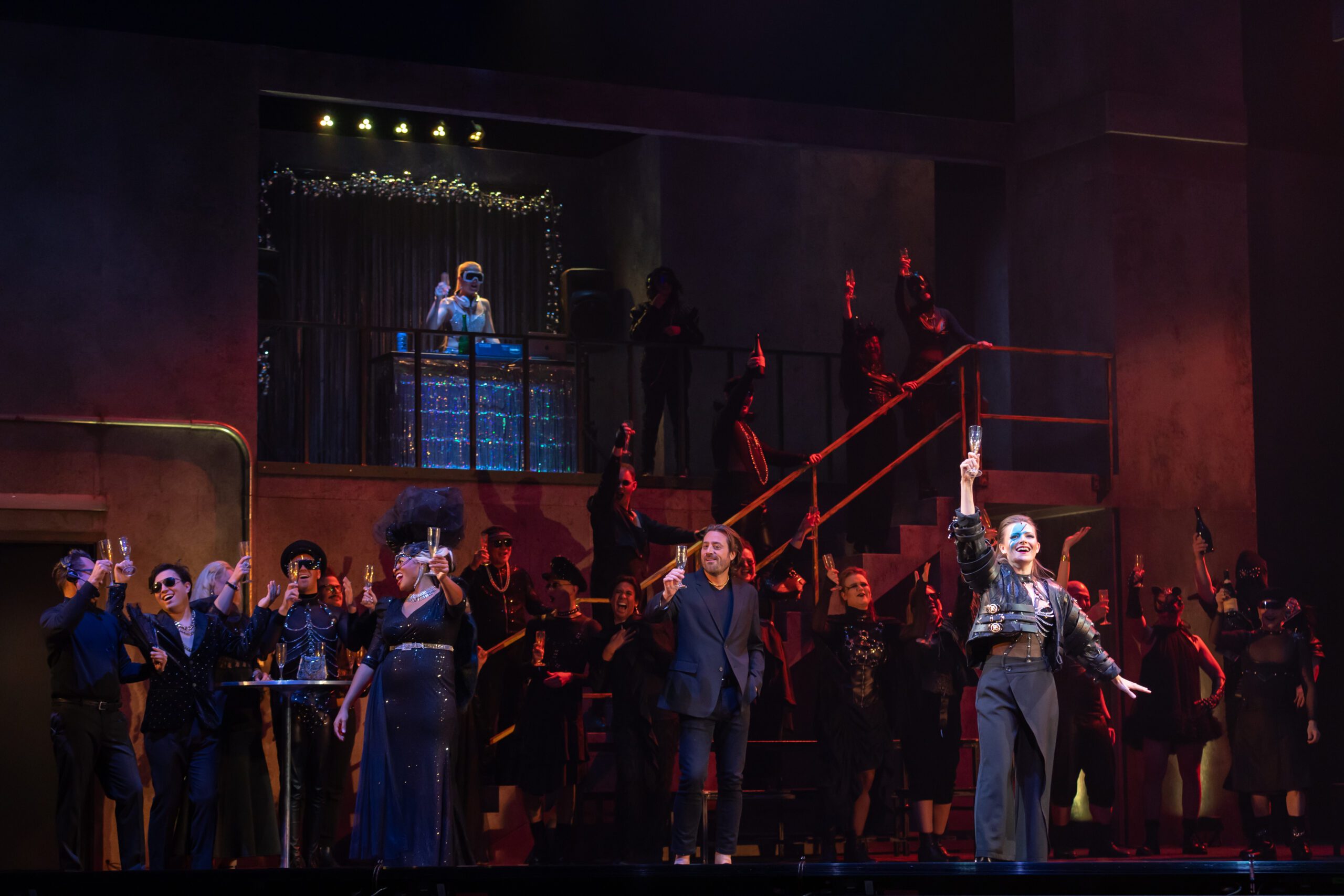Edmonton Opera opened its season on November 7th with a Die Fledermaus at the Jubilee Auditorium that people would recognize as Johann Strauss II’s 1874 operetta, because many of Strauss’s tunes were played and sung. Die Fledermaus has been adapted many times to film and has no doubt been bent into “updated” stage approaches. But Edmonton Opera’s artistic director Joel Ivany directed a reconstruction of the original effervescent light musical comedy with his own flair for disrupting expectations. He does more than set a familiar work in an unfamiliar setting. Lots of opera companies do that, for better or worse. Ivany “modernizes” things, so that the old things become such totally new things that aren’t what they used to be at all.
The reconceptualization of Ivany’s Die Fledermaus takes the original plot and deconstructs it, reassembling it into a story line that only tangentially requires familiarity with the original. Instead of presenting the operetta’s characters interacting over the course of the original plot and finishing up with a dénouement that reconciles all the conflicts and sends the audience off whistling some infectious Strauss melody, Ivany offers his own form that barely maps onto Karl Haffner and Richard Genée’s frothy 19th-century romp. The concept has its own coherence, but it is something completely different.
This Die Fledermaus begins not in Eisenstein’s home, where the original is set, but in a convincing-looking warehouse, designed by Patrick Du Wors, where a group of opera singers are doing a table reading of the original operetta, preparing for an imminent semi-staged production of the actual work. Here, we are introduced to the performers who will sing the parts of Eisenstein, Rosalinde, Adele, Alfred, Falke and the others.
The members of the cast are only in their roles when the director, Peter Monaghan (Henry/Falke) calls them up to stand and deliver one of their musical numbers. Otherwise, they are arts workers dressed in their street clothes, expressing themselves as rehearsing performers, not as the characters they will eventually play in the second act. Connor Hoppenbrouwers (Frank) wore an Oilers jersey to add some local colour to the proceedings.
The cast members portray a diverse array of eccentricities, and in their “real lives” they have their own personal antagonisms and insecurities. The singers playing Eisenstein and Rosalinde, for example, are a recently separated couple, sniping at each other when they’re not being asked to practice their actual roles. This echo of the Eisenstein/Rosalinde acrimony in the operetta is an Ivany addition.

Photo Credit: Nance Price
Jonelle Sills and Peter Monaghan as Rosalinde and Falke in the party scene of Edmonton Opera’s Die Fledermaus
One standout performance in this production was Polish-Canadian soprano Karoline Podolak’s as Adele and Viktoria in Act One. Podolak, who is in the Canadian Opera Company’s Ensemble Studio, has a vivacious stage presence, a beautiful voice and an obvious feel for the pleasure of performing. As Adele, she shone. She commanded attention, because she is so good.
The acrimonious couple, Rebecca/Rosalinde (Jonelle Sills) and Ivan/Eisenstein (Adam Luther) don’t overdo the personal issues in the rehearsal scene, and both sang and acted their roles in the actual Die Fledermaus portion of the production admirably. Sills, in the guise of a Hungarian princess in Act Two, gave a buoyant performance of the Czárdás at the second-act party.
In fact, Ivany and choreographer Anna Kuman gave the cast, including the strong chorus, much lively business in this middle section of the show, and shades of vaudevillian zestiness abounded. Perhaps in a nod to the Brechtian alienation effect, even when the focus was on the singing, a woman playing a DJ, it seemed, high up in a warehouse alcove was waving her arms to the music as though the actual operetta could handle any amount of gratuitous interference. She wasn’t interesting, but she was annoying.
Alfred appears at the beginning and the end of the “real” Die Fledermaus, and so it was in this production. Tenor John Tessier, playing a clownish kind of Eurotrash personality, got the biggest laughs, strutting about with a comedic macho pinache. At one point near the end, his pants came off, and he used his exposed gonch for all its ribald value. Oh, and he sang wonderfully, as well. Danielle MacMillan conducted proceedings at the party as a caricature Prince Orlofsky, laying on the Russian accent thick. Her performance was fine, if not quite as playfully imperious as it could have been.
In the final act, which didn’t take place at the prison where the original finishes but was still in the warehouse, the dissolute performers are sleeping off cast-party hangovers. There’s a murky enough nod to the original revelation that identities have not been entirely transparent and some reference to Falk’s plot to get back at Eisenstein for humiliating him a few years before. But none of that really matters. We’d heard plenty of well-sung and well-played Strauss (the Edmonton Symphony), and the remake of a perennial light-opera favourite held together as a hybrid adventure in “updating” old chestnuts for new audiences and hopefully, for Edmonton Opera’s sake, for traditional ones, too.
One woman behind me, who may have been a novice operagoer, said to her companion, “I had no idea it was going to be this funny.” That was pretty much the goal, so mission accomplished.

Photo Credit: Nance Price
Danielle MacMillan’s Orlofsky gets the party started
Opera Canada depends on the generous contributions of its supporters to bring readers outstanding, in-depth coverage of opera in Canada and beyond. Please consider subscribing or donating today.











